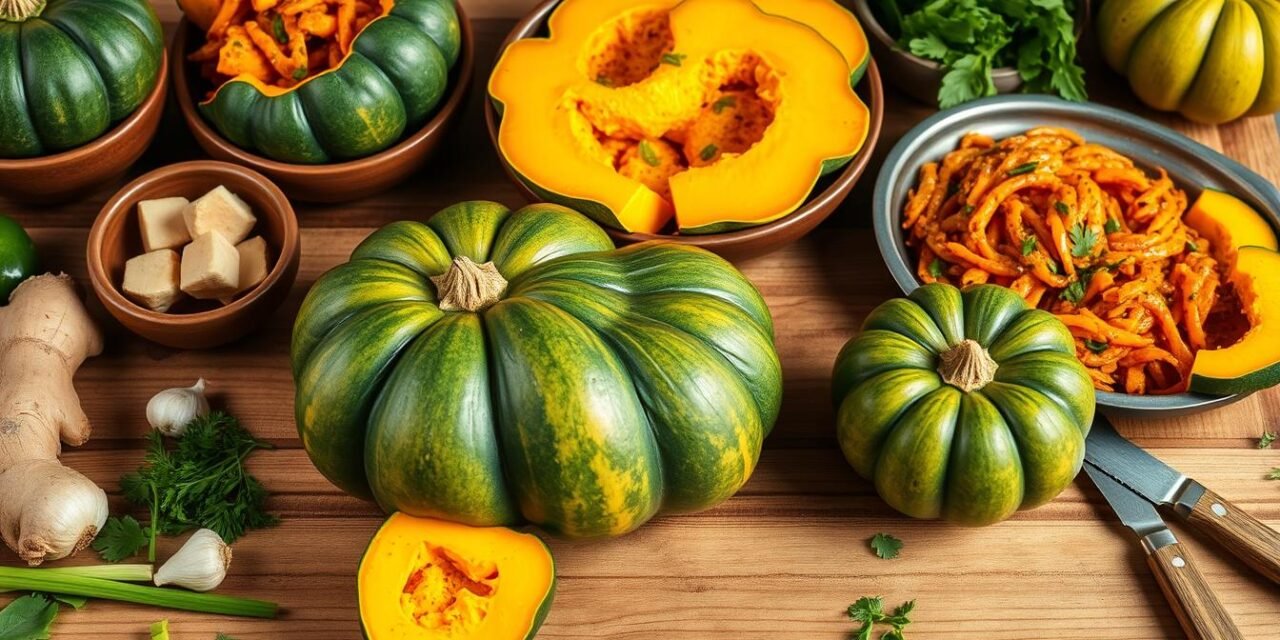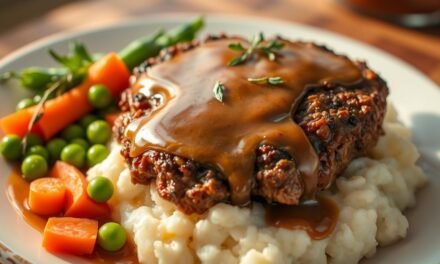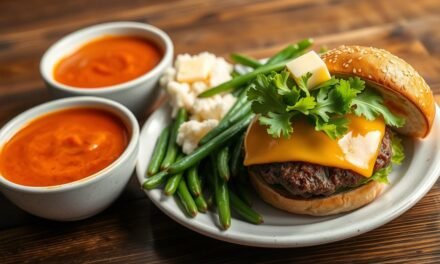I’m excited to share the benefits of kabocha squash. It’s a Japanese pumpkin with a sweet, nutty taste and smooth texture. It’s a favorite in vegan Chinese recipes. Kabocha squash is not only tasty but also full of nutrients, making it great for a plant-based diet. It’s versatile in dishes like stir-fries, curries, and soups, making it a great find for vegan recipes.
In this article, I’ll guide you through making delicious chinese squash recipes kabocha vegan recipes. We’ll cover kabocha squash basics, like its nutritional benefits, how to pick and store it, and different cooking methods. Whether you’re a seasoned vegan or new to plant-based food, this article will give you the knowledge and inspiration to make tasty vegan Chinese squash recipes.
Key Points
- Kabocha squash is a nutrient-rich ingredient perfect for vegan Chinese recipes.
- It can be used in a variety of dishes, including stir-fries, curries, and soups.
- Kabocha squash is a popular ingredient in Chinese cuisine and is known for its sweet, nutty flavor and smooth texture.
- With the right cooking methods, kabocha squash can be a delicious and healthy addition to a plant-based diet.
- This article will provide a step-by-step guide on how to make delicious vegan Chinese squash recipes.
Table of Contents
Overview of Kabocha Squash: The Japanese Pumpkin
Kabocha squash is a versatile and nutritious ingredient. It’s used in many easy kabocha squash recipes, like healthy Chinese vegan dishes. It’s full of vitamins, minerals, and antioxidants, making it good for your health.
It’s also low in calories and high in fiber. This makes it perfect for those trying to lose weight or stay healthy.
When picking a kabocha squash, choose one that’s firm and heavy. A medium squash weighs about 3 pounds. For a single serving, you’ll need about 3/4 pound.
Kabocha squash can be roasted, steamed, or sautéed. Roasting takes about 30 minutes at 400°F. It’s great in soups, stir-fries, and more.
Kabocha squash is high in fiber and vitamins. A serving of roasted squash soup has 4g of fiber and 20g of carbs. It also has about 4g of protein per serving.
| Nutrient | Amount per serving |
|---|---|
| Calories | 167 kcal |
| Protein | 4g |
| Fat | 9g |
| Fiber | 4g |
Essential Tools and Ingredients for Chinese Squash Recipes Kabocha Vegan
To make tasty Chinese squash recipes, you need a few key tools and ingredients. You’ll need a wok or large skillet, a chef’s knife, and spices and seasonings. For a vegan kabocha squash stir-fry, you’ll need a sharp knife, cutting board, and spoon for seeding. It takes under 30 minutes to prepare the squash.
A vegan kabocha squash stir-fry has about 601 kcal per serving. It has carbs: 25 g, protein: 22 g, and fat: 49 g. Important spices include ginger, garlic, and Chinese five-spice powder. Kabocha squash is dense and sweet, unlike other squashes.
Common ingredients in vegan Chinese recipes with Kabocha are soy sauce, sesame oil, rice vinegar, and Chinese Five-Spice Powder. Store Kabocha squash in a cool, dry place for up to a month. Wrap it in plastic wrap after cutting for up to a week in the fridge. Roast it at 425°F, pre-bake for 10 minutes before slicing.
Here is a list of essential tools and ingredients for Chinese squash recipes kabocha vegan:
- Wok or large skillet
- Chef’s knife
- Spices and seasonings (e.g. ginger, garlic, Chinese five-spice powder)
- Soy sauce
- Sesame oil
- Rice vinegar
Kabocha squash has about 50 calories per cup of cooked squash. It has 2,000 micrograms of beta-carotene per 100 grams. The best size for cooking is 2 to 3 pounds. With the right tools and ingredients, you can make delicious Chinese kabocha dishes, including vegan stir-fries.
| Ingredient | Quantity |
|---|---|
| Kabocha squash | 1 medium |
| Sesame oil | 2 tablespoons |
| Soy sauce | 2 tablespoons |
Preparing Your Kabocha Squash
To start cooking with kabocha squash, you need to prepare it right. First, wash and clean the squash to get rid of dirt or bacteria. This is key, more so when making vegan curry, to keep it clean.
Cutting and seeding the squash can be tricky. But with the right tools and methods, you can get a smooth cut. Remember, the squash’s skin is edible and full of nutrients, adding value to vegan recipes.
Before cooking, pre-bake the squash for 18-20 minutes at 400°F. This makes cutting and cooking easier. It’s very helpful when making a big batch of vegan curry.
- Wash the squash well to remove dirt or bacteria.
- Cut the squash in half and remove the seeds and pulp.
- Pre-bake the squash for 18-20 minutes at 400°F to make cutting and cooking easier.
By following these steps and using the right techniques, you can prepare your kabocha squash for cooking. You’ll be able to make delicious vegan Chinese squash recipes, like a tasty vegan curry.
| Preparation Time | Cooking Time | Total Time |
|---|---|---|
| 5 minutes | 25 minutes | 30 minutes |
Traditional Chinese Cooking Techniques for Kabocha
Traditional Chinese cooking has many ways to cook kabocha squash. One favorite is the kabocha stir-fry vegan style. It cooks the squash quickly with veggies and spices in a wok or skillet. This keeps the squash sweet and tender, making it a tasty, healthy meal.
Roasting is another Chinese cooking method that highlights the squash’s sweetness. Cut the squash into wedges or cubes, toss with oil and spices, and roast until tender. It’s great as a side or in many recipes.
When cooking kabocha squash, remember a few tips. Use slices that are at least ¼-inch thick to avoid overcooking. Cook at medium heat for about 4 minutes. Also, you don’t need to peel the skin unless it’s blemished, making it easy to use.
Here are some key nutrients in kabocha squash:
- Calories: 348 per serving
- Carbohydrates: 18 g per serving
- Protein: 17 g per serving
- Total fat content: 23 g per serving
Kabocha squash is great in many dishes, like stir-fries, curries, soups, and salads. Its sweet, nutty taste and firm texture make it a wonderful addition to meals. It’s perfect for a healthy side or to spice up your favorite recipes.
Mastering the Perfect Vegan Kabocha Stir-Fry
To make a tasty vegan kabocha stir-fry, you need to know how to cook kabocha squash. It has about 150 calories per serving. It’s a healthy and tasty addition to any stir-fry. Choose a dark green, hard, glossy skin and a heavy squash.
Pre-cook the squash by baking at 400°F (200°C) for 15 minutes or microwave for 2-4 minutes. This makes the squash tender and easier to handle. For a great vegan stir-fry, cook it with olive and sesame oil, garlic, and ginger.
Popular kabocha squash recipes include miso soup and tempura, showing traditional Japanese cooking. These recipes use simple ingredients, making them great for vegans and vegetarians. By mastering the vegan kabocha stir-fry, you can enjoy a healthy and tasty meal anytime. With the right seasonings and sauce, you can make a dish that’s unforgettable.
Some important tips for cooking kabocha squash include:
* Use a squash that’s 2 to 3 pounds
* Cook it at 400°F (200°C) for 20 minutes or until it’s tender
* Add soy sauce, miso, rice vinegar, and maple syrup to the glaze
By following these tips and trying different recipes, you can become a pro at cooking kabocha squash. You’ll enjoy its health benefits.
Creating a Flavorful Kabocha Squash Curry
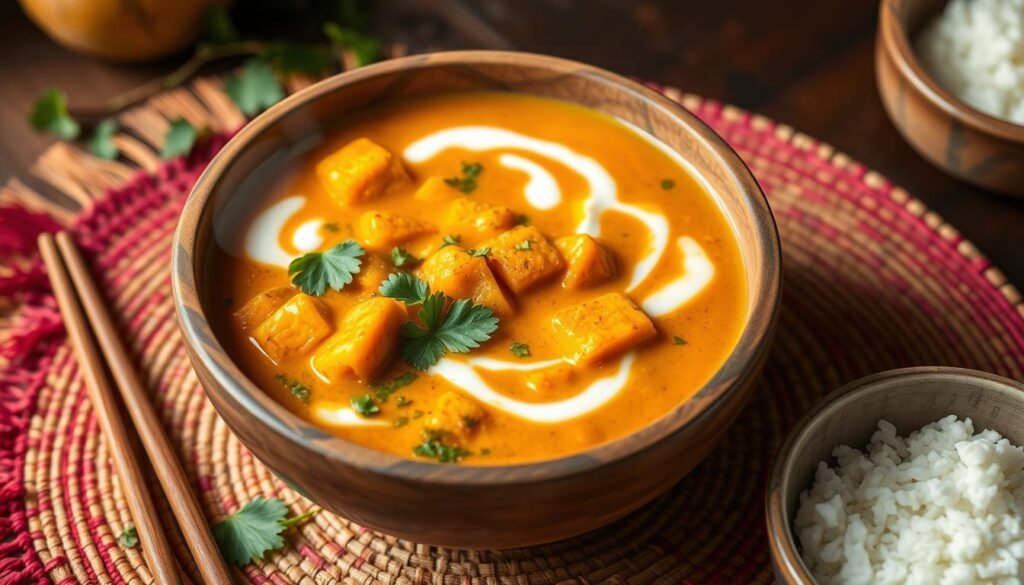
To make a delicious kabocha curry, you need the right ingredients and a few simple steps. Buy kabocha squash in late summer through fall. Roast it in the oven for 40-45 minutes, plus 10 minutes for bigger squash.
Roasted Japanese squash is key for its sweetness and texture. The recipe needs 7 main ingredients and takes under 45 minutes. Start by sautéing onions and carrots for 7-8 minutes until they’re tender.
Then, add roasted squash, chickpeas, and spices like cumin, garam masala, and turmeric.
You can adjust the spices and red curry paste for spiciness. For a low FODMAP version, skip onion and garlic. Use 1 cup of coconut milk and 2 cups of water.
The dish keeps well in the fridge for 4-5 days and can be frozen for a month.
This curry is perfect for a cold winter night. It’s made with roasted Japanese squash and spices. Serve it with a grain for a nutritious meal.
Roasted Kabocha: A Simple Yet Delicious Approach
Roasting kabocha squash is easy and tasty. It makes the squash sweet and smoky. First, heat your oven to 400°F. A kabocha squash weighs 2 to 3 pounds. It costs about $2.69 CAD per pound.
To roast, cook for 20-40 minutes. Roast seeds for 30-45 minutes at a lower heat. Use 1-2 tablespoons of olive oil and season with salt and pepper.
Here are some tips for roasting kabocha squash:
- Preheat the oven to 400°F.
- Use 1-2 tablespoons of olive oil per squash.
- Season with ½ teaspoon of salt and ¼ teaspoon of black pepper per squash.
- Rossing time for kabocha squash is between 20 to 25 minutes.
Roasting kabocha squash is a tasty way to enjoy vegan recipes. It’s sweet and smoky, making it a healthy meal choice. Kabocha squash has 142 kcal, 19g carbs, 2g protein, and 8g fat.
| Nutritional Benefits | Per Serving |
|---|---|
| Calories | 142 kcal |
| Carbohydrates | 19g |
| Protein | 2g |
| Fat | 8g |
Steam and Braise Methods for Tender Results
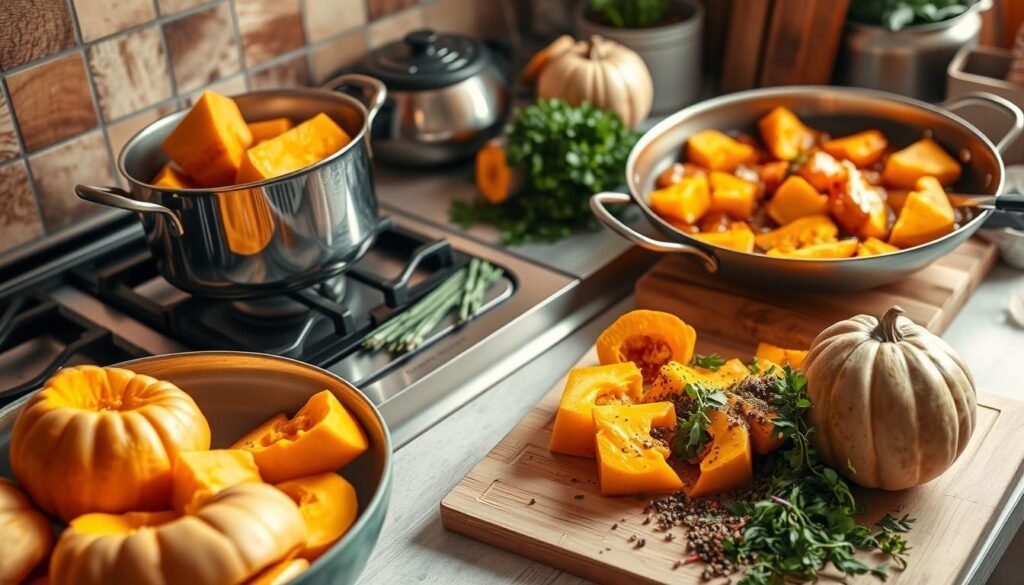
Two traditional Chinese methods are great for cooking kabocha squash: steaming and braising. These methods keep the squash sweet and tender. Steaming uses a steamer basket to keep nutrients and flavor in. Braising cooks the squash in liquid over low heat, making it rich and savory.
To get the best results, learn about traditional Chinese braising and steaming. For braising, use soy sauce, sake, and mirin for flavor. Cook the squash for about 20 minutes until it’s soft. Steaming needs little seasoning, letting the squash’s natural taste come through. It cooks in 10-15 minutes.
Traditional Chinese Braising Techniques
Braising is a favorite in Chinese cooking for kabocha squash. It lets the broth’s flavors soak into the squash. Cook it in a mix of soy sauce, sake, and mirin over low heat for 20 minutes.
Steaming Tips and Tricks
Steaming keeps the squash’s nutrients and sweetness. Use a steamer basket and cook for 10-15 minutes until tender. You don’t need much seasoning, so the squash’s natural taste can shine.
Learning these traditional Chinese methods will make your kabocha squash dishes amazing. Whether you like steaming’s simplicity or braising’s richness, these techniques will bring out the best in this versatile ingredient.
Common Challenges
When cooking kabocha squash, you might face problems like overcooking, undercooking, or a lack of flavor. To solve these, knowing the best ways to cook and the right mix of ingredients is key. Kabocha squash usually weighs 2-3 pounds for cooking. It’s best stored in a cool, dry place for up to 4 months and.
Some important things to keep in mind include:
- Watch the cooking time and temperature to avoid overcooking or undercooking
- Adjust the seasoning and spices to make the flavor better
- Choose the right cooking methods, like roasting or steaming, to highlight the squash’s natural sweetness
Kabocha squash is packed with vitamins A and C and fiber, making it great for a healthy diet. Knowing how to tackle common problems lets you make tasty and healthy kabocha squash dishes easily.
For instance, the kabocha curry recipe says to simmer for 15 to 20 minutes to get the squash soft and the flavors to mix well. The Miso-Glazed Roasted Kabocha suggests roasting at 400°F for 35-40 minutes. By following these tips, you can get perfect results and enjoy kabocha squash’s health benefits.
| Cooking Method | Cooking Time | Temperature |
|---|---|---|
| Roasting | 35-40 minutes | 400°F |
| Steaming | 15-20 minutes | N/A |
Storage and Meal Prep Tips for Kabocha Dishes
To keep your kabocha dishes fresh, follow these storage and meal prep tips. Uncooked and pre-cut kabocha can last 2-3 months in the freezer. Cooked kabocha stays fresh in the fridge for 3-4 days. Portioned meals can last 3 days in an airtight container.
Reheating cooked kabocha keeps it fresh for 3 to 4 days. Frozen kabocha needs 10-20 minutes of simmering. If thawed, it cooks in about 10 minutes. Here are some tips for storing and reheating kabocha dishes:
- Store uncooked kabocha in a cool, dark place for up to 14 days.
- Wrap cooked kabocha in plastic and store in the fridge for up to 28 days.
- Use 1-2 tablespoons of oil for cooking and add up to ¼ cup of water when cooking from frozen.
By following these tips, you can enjoy your kabocha dishes longer. A single serving has 155 calories, with 13.6g of sugar, 884.1mg of sodium, and 5g of protein.
Choose the right kabocha squash. It should have a dull and firm skin, a dry and cracked stem, and a light yellow patch. With these tips, you’ll be a pro at storing and meal prepping your kabocha dishes.
Conclusion: Mastering Vegan Chinese Kabocha Cooking
As we wrap up our vegan Chinese kabocha cooking journey, I’m sure you’re ready to make tasty dishes at home. You now know the health perks of this Japanese pumpkin and how to cook it well. You’re all set to improve your plant-based cooking skills.
Learning to cook with vegan Chinese kabocha takes time and practice. Be patient and open to trying new flavors and ingredients. Don’t hesitate to mix things up and find what you like best.
Keep exploring ways to use kabocha squash in your vegan Chinese dishes. You can roast, stir-fry, or steam it. Add spices, herbs, and bold sauces to make your dishes stand out.
The secret to getting better at vegan Chinese kabocha cooking is to be adventurous and enjoy the process. Let this amazing vegetable guide you to making healthy, tasty plant-based meals. Happy cooking!

